The incorruptible cadaver of Saint Bernadette.
Swiss Guards in Renaissance finery; solemn monks holding candles; a male choir chanting in the occult tongue of Latin; the anguished faithful, wracked with grief, clasping their hands in prayer or seeming to clutch at the passing bier; and, at the center of this deeply pagan drama, the flesh made word–the dead pontiff, caught in mid-flight between the mortal and the marmoreal, the all too human and the already hallowed. Joel-Peter Witkin, eat your heart out: Nobody does High-Gothic spectacle like the Vatican.
“Smells and bells,” believers call it: the ritualized technologies of mass mind control. For centuries, no institution was more masterfully skilled at manufacturing the consent of the illiterate million than the Catholic church.
In Rosemary’s Baby, the friendly nieghborhood Satan-worshippers, Roman and Minnie, are thoughtful on this point:
Roman: No Pope ever visits a city where the newspapers are on strike.
Minnie: I heard he’s gonna postpone and wait till it’s over.
Guy: Well, that’s show-biz.
Roman: (chuckling) That’s exactly what it is. All the costumes or rituals, all religions.
Borne from the Apostolic Palace, through St. Peter’s Square, and into St. Peter’s Basilica, the earthly remains of John Paul II looked, for all the world, like a prop in a gothic opera, his kabuki-white features contrasting melodramatically with his blood-red vestments. Robed and mitered, he looked doll-like, a chess-set bishop sculpted in life-size proportions by Madame Tussaud, an unstrung puppet with his “feet turned outward awkwardly, the skin of his face chalky and drawn taut,” as the New York Times correspondents Elaine Sciolino and Daniel J. Wakin put it, in their wonderfully poetic description of the scene.
Under John Paul II, Team Vatican’s inquisitional intolerance for self-abuse, sex before wedlock, birth control, abortion, divorce, homosexuality, and other works and ways of the Devil cost it global market share. According to an op-ed by Thomas Cahill in the Times, “The situation is dire. Anyone can walk into a Catholic church on a Sunday and see pews, once filled to bursting, now sparsely populated with gray heads.”
Even so, who can deny that, when it comes to ritualistic pomp and circumstance, Roman Catholicism simply knocks the spots off Religion, American-style? A devout atheist to the death, I stand, nonetheless, with the splenetic contrarian Camille Paglia, who never misses an opportunity to rant against what she perceives as the church’s clueless attempts to rebrand itself, from Vatican II onward. “My dissatisfaction from American Catholicism, which partly began during my adolescence in the late 50’s, was due partly to its increasing self-Protestantization and suppression of its ethnic roots,” Paglia told the Buffalo News, in April, 1995. “Within 20 years, Catholic churches looked like airline terminals: no statues, no stained-glass windows, no Latin, no litanies, no gorgeous jeweled garments, no candles, so that the ordinary American church now smells like baby powder.”
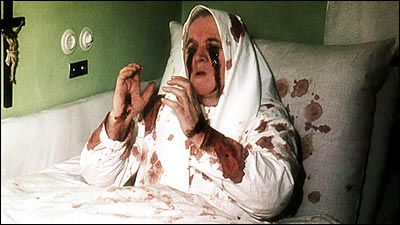
German stigmatic Theresa Neumann. Photo courtesy Living Miracles.net.
Indeed, the understated grand guignol of the pope’s posthumous procession, equal parts medieval mystery play and prime-time spectacle, offers a timely reminder that these are the people who brought you Saint Bartholomew, the flayed martyr with his skin flung jauntily over one shoulder, and the beatified truckstop waitresses Saint Lucy and Saint Agatha, serving up their plucked-out eyeballs and severed breasts on platters, like blue-plate specials.
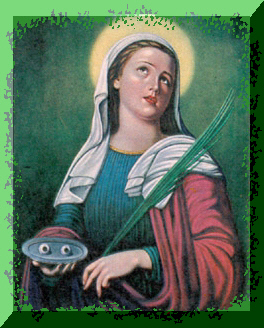
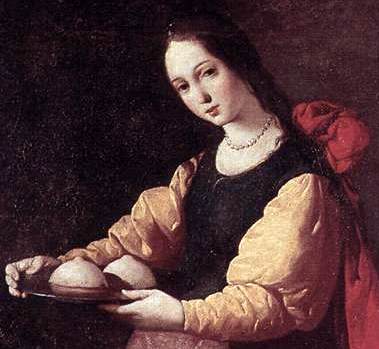
Yes, the pope has that futurrific little popemobile, and yes the Holy See’s website is the bitchenest thing in online branding for Bronze-Age belief systems. And yes, the Vatican e-mailed and IM’d the bad tidings about the Holy Father’s death to a breathless press. (What did you expect? An archangel with a flaming sword?) Even so, Catholicism, at its thorn-crowned, gore-dripping (sacred) heart, amounts to an inescapably pagan take on Christianity. With its martyrs and its miracles, its relics and its stigmata, its exorcisms and excommunications, the Holy Roman faith is the Christian Gothic.
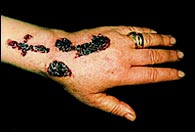
Natuzza Evola, stigmatic.
Is this why Catholics and lapsed Catholics are overrepresented in the congregation of Gothic novelists? The famously Catholic Flannery O’Connor wrestled with theological demons against a Gothic backdrop, and Anne Rice, the Mother Confessor of palely loitering goths everywhere, was raised in a fervently Catholic household and once dreamed of being a nun. Ironically, the Gothic aesthetic sprang from the brow of anti-Papist Protestants such as Matthew Lewis, who associated the Catholicism of the Middle Ages with inquisitional cruelties and a dogged hostility toward science and society’s first, feeble gropings toward the Enlightenment. (Go figure!) Lewis’s novel The Monk (1796) chronicled the secret, De Sadean depravities of one of God’s Servants, who boinks his pious groupies, dabbles in witchcraft, and conjures up abominations in the consecrated crypts beneath his abbey. (Ah, well, who are we to be critical? “We are all as an unclean thing, and all our righteousnesses are as filthy rags…” [Isaiah 64:6].)
Of course, Catholicism inherits its Gothic tendencies from its parent religion. Christianity worships a revenant stiff, for God’s sake; its devotees wear an instrument of capital punishment around their necks, and its most sacred rite is a blood feast that reads like Anne Rice fanfiction at its most lurid (“Whoso…drinketh my blood, hath eternal life; and I will raise him up at the last day”). Catholicism is just Christianity with its graven images showing, Christianity with one foot in the chthonic.
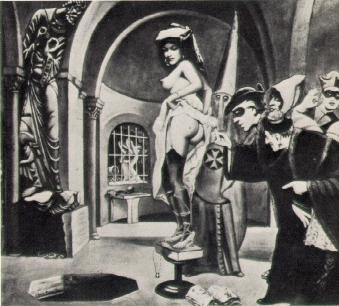
Stigmata Diaboli (“Mark of the Devil”)(1960), by the renegade Surrealist Clovis Trouille.
Which is the larger part of its charm, of course. In stark contrast to the extruded, suety Christianity retailed in megamall megachurches like Robert Schuller’s happy, shiny Crystal Cathedral, Catholicism offers the uncanny consolations of mummified Capuchin monks, the preserved head of Catherine of Siena, the Stations of the Cross (the Iron Man Decathlon of sadomasochism), the homoerotic agonies of Saint Sebastian, and the dewy browed ecstasies of Saint Theresa, pierced by the immaculate unit of Our Heavenly Father. Did I mention a lifetime’s worth of gnawing guilt (see: “We are all as an unclean thing,” etc., etc., above), temporarily expiated through the breathy, phone-sex ritual of whispering your juiciest True Confessions through the grillework of a Gothic phonebooth, into the eager ear of one of the Eunuchs of Heaven?
No wonder that four out of five enfants terribles ask for Catholicism by name when they get tired of playing whack-a-mole with plaster saints and revert to bourgeois form. Consider Salvador Dali: A virulent anti-cleric like much of the French avant-garde he ran with when Surrealism was the New, New Thing (think of the priests mocked as beasts of burden in Un Chien Andalou, dragging a piano full of rotting donkeys), Dali ended up a theatrically pious Catholic, his Christ of Saint John of the Cross (1951) a gift-shop staple.
Likewise, consider the pilgrim’s progress of Patti Smith, whose 1975 punk-rock anthem, “Gloria (In Excelsis Deo),” is a symbolic profanation of the host. Drawling snidely about how Jesus died for somebody’s sins, but not hers, Smith kick-started punk rock (and her career) with the time-tested tactic of bitch-slapping the bourgeoise. Sex and sacrilege set to a dry-humping rhythm, “Gloria” was cannily calculated to give The Catholic League of Decency a cardiac event. What better way to certify your street cred?
Fast forward to “Wave,” on the 1979 album of the same name, where we find Patti having a Hallmark Moment with the pope. In an adenoidal little-girl voice that bears an alarming resemblance to Lily Tomlin’s Edith Ann, Smith goo-goos about an imaginary audience with the Holy Father:
i saw i saw you from your balcony window
and you were standing there waving at everybody
it was really great because there was about
a billion people there, but when i was waving to you,
uh, the way your face was, it was so, the way your face was
it made me feel exactly like we’re
it’s not that you were just waving to me, but
that we were we were waving to each other.
really it was really wonderful…
…goodbye.
goodbye sir.
goodbye papa.
(Cue footage of New York’s balding punk alumni, Class of ’75, flinging themselves lemminglike into the East River.)
Why would the woman who snarled, in “Babelogue,” that she hadn’t “sold herself” to God start slinging the papal bull? For the same reason that the market-smart Dali traded in his gently used Surrealism for the Holy Roman faith when Surrealism’s shock appeal went from cult to cute. What’s an aging avant-gardist to do, once there are no bourgeoisie left to epater? Epater the bohos! Scandalize lockstep nonconformists everywhere by going normal! Shock the been-there, triple-pierced-that, Disinformation demographic that wears its ennui like a designer trucker’s cap with your ironic embrace of a normalcy so insistently normal it’s downright creepy.
Strapping a lobster to your head and fantasizing aloud about the sensuous curve of Hitler’s buttocks no longer landing you among the boldfaced names on Page Six? Tossing off zany bon mots like “the only difference between me and a madman is that I am not mad” not setting the table aroar the way it used to? Tear a page from the Dali playbook: Declare that the academic realist Meissonier could paint circles around Picasso, insist that Franco’s fascism saved Spain, and–if you really want to pin everybody’s ears back–convert to Catholicism and start cranking out Lourdes gift-shop chromos like Crucifixion (1954).
Sure, you can always grow a Van Dyke, cultivate a morgue-slab pallor, and join the Church of Satan, but how transgressive can a cult be that claims Sammy Davis as one of its charter members, for chrissakes? Besides, Satanism is just a backwards-masked version of Roman Catholicism. It still kneels at the same altar; it just does it backwards, buttocks bared, hoarsely bellowing hymns of praise to Cthulhu in its best Norwegian death-metal growl. Why settle for a lame mullethead parody of the ultimate goth faith when, for a song and a prayer, you can have the Real Thing, replete with swinging censers, severed fingers, extreme unction, uncorruptible saints, and transubstantiation (in which the consecrated host is miraculously transformed, as it slides down your gullet, into the flesh of God Almighty)?
Of course, Vatican dogma is a lot less tragically hip than its Hammer Horror stagecraft. Sure, the Pope’s posthumous processional blew the vestments off the drive-through McRituals, awash in self-help homilies and feelgood ecumenical mush, that pass for Christian worship in America’s supersized suburban churches. But John Paul’s doctrinal positions were Gothic in a less fashion-forward sense. Not for nothing did Molly Ivins call him the greatest mind of the Middle Ages.
For the next 15 media minutes, of course, anti-Papism is the new anti-Semitism. As Philadelphia Inquirer commentator Ken Dilanian helpfully points out, “the media are doing now what they did when former President Ronald Reagan died in June: reducing a deeply controversial figure to a warm, grandfatherly caricature.”
Well, forgive me, Father, I know not what I do. I’m going to risk being tarred as Jack Chick Jr. by issuing an encyclical of my own: A Holy Father who orders his billion-member flock to eschew birth control, at the gunpoint threat of excommunication, even as AIDS rides a pale horse through their hospital wards, is guilty of child abuse on a global scale. According to the Nation columnist Katha Pollitt, “in Africa, where HIV infects millions–20 percent in Kenya, 40 percent in Botswana, 34 percent in Zimbabwe–Catholic clergy, who oppose condoms as they do all contraception, are actively promoting the myth that condoms don’t prevent transmission of the virus and may even spread it.” AIDS is slaughtering the innocent and the sinful alike, yet this Pope insisted that the faithful adhere to a suicidally misguided doctrine straight out of the Dark Ages. This is genocide, plain and simple. On in a blog post on his now-shuttered website, the Leftist firebrand Marc Cooper minced no words:
I firmly believe that the Church (and religion more generally) are medieval institutions that celebrate and propagate fear and ignorance. The positive record of the currently-deceased Pope is well known. But it hardly balances out the sheer inhumanity of Church dogma that he steadfastly defended. I personally could give a flip if women are or are not allowed into the priesthood (an institution that should be abolished). What I do care about is the AIDS infection rate world-wide and the vast, staggering complicity of the Church in its preaching against condoms and, alas, birth control. Suffering, says the Church, is God’s great gift to man. Nice words from those who inhabit gilded palaces and reign as Rome’s greatest landlord. Any truly great Pope would do to the Church what Gorbachev did to Communism–hasten its extinction.
By all accounts, Karol Wojtyla was a nice man. But is niceness next to godliness? Doubtless, he lifted the spirits of the anxious pilgrims who knelt to kiss his ring or hoisted their babies aloft for a benedictory peck from the Bishop of Rome; where’s the harm in that?
Even so, I’m as convinced as any godless apostate can be that when we die, we all go–good and evil alike–to the same worm-turned earth. Of course, I could be wrong. Maybe John Paul is riding his popemobile triumphally through the City of God, even now. From here, though, his earthly legacy looks like a Cloud of Unknowing, and a toxic one, at that.
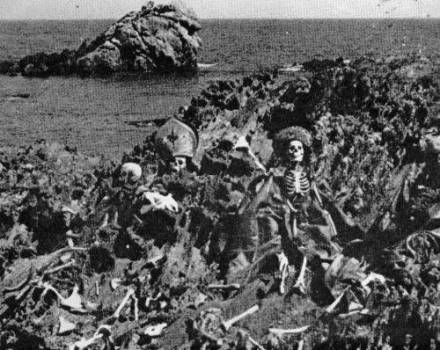
L’Age d’Or (1930), Luis Bunuel and Salvador Dali.

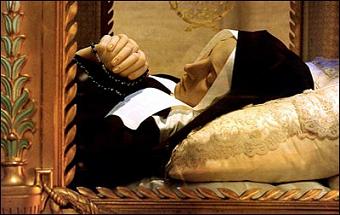
Isaac B2
Any faith with adherents that can find holiness in grilled cheese sandwiches has that magical, mystical spectacle thing down pat.
M. Dery
If the grilled cheese sandwich is the new Shroud of Turin, the magical and the mystical have taken a serious hit.
SV
You had me fascinated until you started calling Christianity a “parent” of Catholicism. For someone so apparently well-educated, you tread dangerously close to the appallingly common bigotry that considers the one exclusive of the other.
Say what you like about the internal sins of either, but Catholicism is a form of Christianity. It is not separate from it.
M. Dery
Precisely my point in calling Christianity the “parent” faith. In other words, Christianity is the *religion*, of which Catholicism is a *denomination* —a distinction often lost not only on anti-papist bigots but on Catholics themselves. In my highly unscientific straw poll, followers of the Holy Roman faith not infrequently refer to Catholicism as their “religion.”
Jacob C.
I forget who originally came up with this little bon mot, as it’s not original to me, but it definitely applies to me: Every day people are leaving the churches and going back to God.
My faith is a personal thing between me and whatever’s in charge out there; I don’t need some earthly organization to mediate.